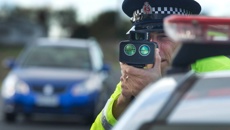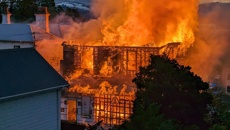
Robert Bakhuis doesn't want to circle back.
He keeps a low profile, living quietly in a small South Island town, and refuses to discuss the events of 50 years ago.
Those dark days should remain in the past — buried by the passage of time, he argues when contacted by the Otago Daily Times this week.
"People like me like to move on," he said.
"I'm not proud of what I did. It's something I'll regret for the rest of my life."
But it is a story that once hit the headlines on both sides of the Tasman — a stolen plane, a fruitless search and a two-year mystery, solved only when Mr Bakhuis, so to speak, came back from the dead.
/arc-anglerfish-syd-prod-nzme.s3.amazonaws.com/public/FN2YLLBRZFBUDFULCPRSHJCWBM.png)
The Cessna 150 ZK-CGI, once ditched in Lake Duncan and later restored to airworthiness. Photo / ODT
In 1970, Mr Bakhuis was a 19-year-old working towards a private pilot's licence, flying Cessnas out of the Otago Aero Club's aerodrome on the Taieri Plain.
He had accrued more than 30 hours' flight time and was considered a confident trainee — perhaps too confident, his instructors were later to suggest.
His one fear was of flying over water, they said.
But early on February 3, something was different.
Instructors arriving at the club that morning found a stolen car abandoned outside the hangar, and the hangar doors left open.
Inside, three life jackets and a flight helmet were missing and there was an empty space where one of the club's aircraft, a Cessna 150 registration ZK-CGI, should have been.
It was 5.50am and Mr Bakhuis was already in the air.
Over the next two and a-half hours, there were sightings of ZK-CGI as Mr Bakhuis headed southwest on a seemingly erratic course.
After first being spotted over Balclutha, sightings of the aircraft came in from Garston at 7am and Dipton at 7.30am.
Other reports, later found to be false, placed the aircraft over much of the South Island.
The final sighting was a report of the aircraft flying up the Routeburn Valley, but after that, the trail went cold.
Acquaintances of Mr Bakhuis later told police he had told them he planned to steal a plane, ditch it in a Fiordland lake and "go bush".
But the aircraft was believed to be carrying enough fuel for a flight of more than 400km — putting much of the South Island within range.
After an initial flurry of sightings and media reports, a series of air and ground searches turned up nothing.
Authorities deemed a prolonged search "pointless" and settled in to wait.
"Obviously, the plane could have come down anywhere in a great expanse of wild country. A chance sighting by a plane or by a hunting or tramping party might one day solve the mystery," the ODT reported at the time.
Fast forward 50 years to the present day, and Otago Aero Club chief flying instructor John Penno still recalls Mr Bakhuis' story.
/arc-anglerfish-syd-prod-nzme.s3.amazonaws.com/public/BAOJBZOMTFD6NBCL26VOLNEJCI.png)
New owner Steven Elliott (right), pictured with aviation identity Lew Day at Ardmore Airport on the day Mr Elliott purchased ZK-CGI from Airworks on February 28, 1983. Photo / ODT
Mr Penno had just joined the club when Mr Bakhuis and the club's Cessna disappeared, and recalled the confusion.
Instructors initially assumed the Cessna was off on a legitimate flight, but as the hours dragged on, doubts grew.
"All of a sudden a topdressing pilot came down and said, 'Hey — my helmet has gone missing out of my topdressing aircraft," he said.
"We thought, 'That's odd' — then another guy came and said, 'Hey look, my lifejacket has been pinched out of my aircraft'. Then they rang the cops and that was that.
"He'd gone missing and we never heard a word."
Years passed with no more clues as to the fate of Mr Bakhuis or the club's aircraft, until one day in 1972 when the club's phone rang.
"This lady rang up and said, 'Look, I'm the mother of [Mr Bakhuis] who took that aircraft. I've got all this flying gear here ... I might as well bring it out and drop it off," she said.
The club accepted the items with thanks, and, later the same day, after the mother had returned home, there was a knock at her door.
"There was her son. He'd come home," Mr Penno said.
Police records showed Mr Bakhuis had finally returned to Dunedin in July 1972 — more than two years after his disappearance — and been arrested.
By then, Mr Bakhuis' mother had come to believe her son must certainly be dead. Fate proved her wrong and soon the truth behind his disappearance came tumbling out.
Mr Bakhuis told police he had flown to Fiordland and ditched his aircraft in Lake Duncan, survived the landing and managed to swim to shore, leaving the aircraft to sink to the bottom of the lake.
In the Dunedin Magistrate's Court, it emerged Mr Bakhuis had already been on bail, awaiting sentencing over charges of unlawfully taking vehicles and theft, and fled out of fear of the restrictions the court was likely to impose.
He undertook a potentially suicidal act fraught with danger after deciding to let fate decide, his lawyer told the court.
After stealing the Cessna and ditching it in Lake Duncan, Mr Bakhuis survived five weeks in the bush with just two days' food, before emerging and managing to slip away to Australia.
/arc-anglerfish-syd-prod-nzme.s3.amazonaws.com/public/4YVA3LNWWBDIJPGMCOW5MTVI7U.png)
The Cessna 150 ZK-CGI (just below the Spitfire), which trainee pilot Robert Bakhuis stole, flew to Fiordland and ditched successfully in Lake Duncan. Photo / ODT
There he was to remain for much of the next two years, despite a brief trip back to New Zealand and then back to Australia.
His "self-imposed exile" was a lonely experience, as Mr Bakhuis travelled across much of Australia for work, his lawyer said.
While there, he confronted the reality of isolation from his family and "wrestled with his problems, knowing that he wanted to return", the lawyer said.
Eventually, he did, initially to the North Island before a shift south to Christchurch, where he found work in April 1972.
Then, in July that year, he travelled south to Dunedin, knocking on his mother's door in the early hours of July 12.
Later, he called a lawyer, then the police, and handed himself in to face the music.
That was despite him holding a Swedish passport which could have allowed him to slip further out of reach. He opted to destroy the document instead, the lawyer told the court.
After admitting the charges against him in court — including one of unlawfully taking an aircraft — he was sentenced to six months' imprisonment.
In sentencing him, the magistrate, Mr Murray, described Mr Bakhuis' offending as "bizarre" but gave him credit for maturing "a great deal" and returning to face his punishment.
He also noted Mr Bakhuis appeared to have been attempting to emulate his father, who had been involved in heroic actions in wartime resistance during World War 2.
After that, Mr Bakhuis' story slowly began to fade into obscurity.
But Mr Penno, speaking to the ODT, said he had maintained an interest in the story and kept a scrapbook of newspaper articles from the period.
Eventually, Mr Bakhuis turned up again at the Otago Aero Club, this time to apologise.
"He came out and apologised here ... I've never met the guy, but one of the guys here said, 'Get the f... out of here'.
"I said, 'Why'd you talk to the guy like that?' and he said, 'He's the guy who pinched our aeroplane'."
Mr Penno learned, from speaking to others, Mr Bakhuis had a reputation as a bright student of "above average" ability as a pilot — despite a sometimes "abrasive" attitude.
At the time, the decision to ditch the aircraft was described by some as "a difficult task for a good pilot" , while others used a different word — "suicidal".
Mr Penno believed Mr Bakhuis' performance in ditching the aircraft required "a fair amount of skill and a personality that could handle that kind of stress, because that's stressful".
Pilots had to descend towards the water and then "flare" the aircraft at the last minute, raising the aircraft's nose and slowing the impact speed.
"But sometimes, when you're over especially calm water, your depth perception is lost. You focus slightly under the water, so a lot of guys who are inexperienced will flare too low and smash into the water.
"In actual fact, what he did in reality was an amazing feat."
/arc-anglerfish-syd-prod-nzme.s3.amazonaws.com/public/FMEQDGCPINBQFFATWRUETBDLRU.png)
The interior of the Cessna 150 ZK-CGI which Robert Bakhuis, a trainee pilot, stole, flew to Fiordland and ditched successfully in Lake Duncan. Photo / ODT
But that was not the end of the story.
After Mr Bakhuis reappeared in Dunedin and the facts came out, a recovery operation was launched.
The aircraft was found by a private salvage team, intact and structurally sound, lying at the bottom of Lake Duncan later in 1972.
Its new owner — the New Zealand Insurance Company — called for tenders for its purchase "as is, where is", resulting in 18 expressions of interest.
Eventually, a buyer was found and a diver descended into the darkness to attach lines to the aircraft, lift it to the surface and pull it on to the shore.
The motor, undercarriage and a window were damaged, as was one wingtip from when the aircraft had touched down and spun, but otherwise it remained sound.
It was eventually acquired and refurbished by general aviation company Airwork, after previously being owned by a Balclutha man.
The company intended to sell it or scrap it for parts — whichever came first — when Fielding man Steven Elliott came across it in late 1982.
He checked it out and learned of its backstory, but was confident it was airworthy and decided to buy it early the following year.
Mr Elliott added his own refurbishments and flew it back down to Dunedin, where he picked up an instructor.
The pair then retraced Mr Bakhuis' original flight to Lake Duncan, located to the west of Lake Te Anau at an altitude of about 1500m.
He found the experience of flying into the remote, mountainous area "quite claustrophobic".
"I had a few hundred hours of flying experience at the time.
"What I'll give the guy is he had a lot of nerve, or stupidity, because that was a tough place to fly into, even with an instructor, for me," Mr Elliott said.
Mr Elliott went on to enjoy more than 2000 hours of flying time in ZK-CGI, and never had any doubts about his purchase.
"It was just the right ticket for me — it was cheap flying and a good aeroplane.
"It never let me down."
But the aircraft continued to have one particular quirk, Mr Elliott recalled.
"It was a funny thing. On a warm day, you could almost smell the bottom of the lake in it. It's a smell I'll never forget.
"It wasn't an objectionable smell. It was my aeroplane smell."
Eventually, after wearing out the engine and struggling to find a suitable replacement, Mr Elliott decided to park the aircraft at the Tauranga Classical Air Museum.
It remains there today, hanging from the ceiling in a prominent position — grounded but never forgotten.
"I've got a piece of New Zealand history there. It's a wonderful aeroplane and I really love it," Mr Elliott said.
"Whenever I go down anywhere south of Timaru, everybody runs up and says, 'Oh, I know that aircraft — where's it been?"'
Take your Radio, Podcasts and Music with you









